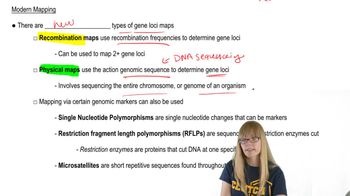Table of contents
- 1. Introduction to Genetics51m
- 2. Mendel's Laws of Inheritance3h 37m
- 3. Extensions to Mendelian Inheritance2h 41m
- 4. Genetic Mapping and Linkage2h 28m
- 5. Genetics of Bacteria and Viruses1h 21m
- 6. Chromosomal Variation1h 48m
- 7. DNA and Chromosome Structure56m
- 8. DNA Replication1h 10m
- 9. Mitosis and Meiosis1h 34m
- 10. Transcription1h 0m
- 11. Translation58m
- 12. Gene Regulation in Prokaryotes1h 19m
- 13. Gene Regulation in Eukaryotes44m
- 14. Genetic Control of Development44m
- 15. Genomes and Genomics1h 50m
- 16. Transposable Elements47m
- 17. Mutation, Repair, and Recombination1h 6m
- 18. Molecular Genetic Tools19m
- 19. Cancer Genetics29m
- 20. Quantitative Genetics1h 26m
- 21. Population Genetics50m
- 22. Evolutionary Genetics29m
4. Genetic Mapping and Linkage
Mapping Genes
Problem 17b
Textbook Question
Textbook QuestionDrosophila females homozygous for the third chromosomal genes pink and ebony (the same genes from Problem 16) were crossed with males homozygous for the second chromosomal gene dumpy. Because these genes are recessive, all offspring were wild type (normal). F₁ females were testcrossed to triply recessive males. If we assume that the two linked genes, pink and ebony, are 20 mu apart, predict the results of this cross. If the reciprocal cross were made (F₁ males—where no crossing over occurs—with triply recessive females), how would the results vary, if at all?
 Verified Solution
Verified SolutionThis video solution was recommended by our tutors as helpful for the problem above
Video duration:
2mPlay a video:
366
views
Was this helpful?
Related Videos
Related Practice
Showing 1 of 2 videos


